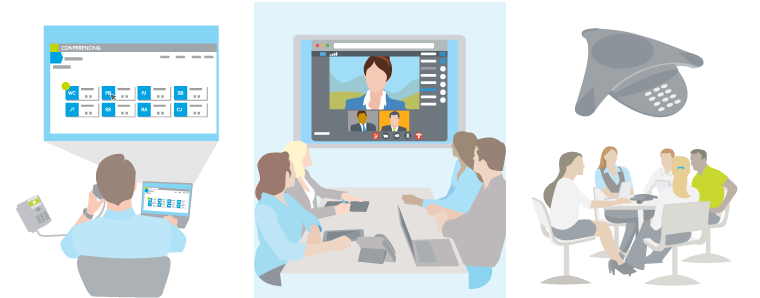What is web conferencing? And how is it different from video conferencing and a regular conference call?
Web conferencing, video conferencing, and conference calling are all real-time communications technology. Except there’s no video image involved in web conferencing, which means you save on the additional hardware that usually is required for a video conference. Also, a web conference is typically run from an online interface, granting you much more control over a meeting than you’d have with a simple conference call.
Web conferencing is also referred to as visual conferencing and online meetings.
Conferencing technologies have become popular with businesses because they’re money- and time-saving technologies that also help enhance productivity. In a recent survey, 75% of managers believed web conferencing would eventually replace conference calling.
Advantages of Web Conferencing
Web conferencing comes with many of the same inherent advantages of the other types of conferencing, such as:
#1. Reduce travel costs
With web conferencing available, employees don’t have to travel across state lines and national borders to important meetings. Businesses that utilize conferencing options have, on average, saved 30 percent in travel costs. It’s also easier on the environment.
#2. Empower remote workforces
In 2016, 43 percent of Americans said they performed some work remotely, and this number is only expected to rise in the coming years. Conferencing creates opportunities for remote workers to connect with office-based employees on a professional and personal level, which can be important to overall company productivity.
#3. Increase efficiency and flexibility
Conferencing helps geographically diverse teams to coordinate more easily, increasing engagement across the different teams, as well as speeding project completion. A majority of surveyed organizations (75 percent) plan to use some form of conferencing.
Specific Advantages of Web Conferencing
On top of these benefits, there are other advantages specific to web conferencing. When stacked up against video conferencing, web conferencing can’t deliver face-to-face communication. However, it does come with benefits like:
#4. Lower costs
Web conferencing is— generally speaking—a more affordable solution compared to video conferencing. Many of these costs are connected to the next benefit, which is:
#5. No new hardware required
Most video conferencing solutions require you to purchase new equipment. Web conferencing uses your existing hardware, usually your computer or your phone.
#6. Simple link to log in
Logging in to a web conference is often easier than logging in to a video conference. With Jive Visual Conference, participants are called once the conference has begun, so no one has to hang out on the bridge waiting for the call to start.
But if you’re going for a stripped-down solution, why not go with regular old conference calling? Most voice services include some kind of audio bridge for conference calling. But what conference calling is missing are the precise call-management controls that come with web conferencing:
#7. Know who is on the call
On a typical conference call, you have to ask, “Who’s here.” On a web conference call, participants are displayed on the interface.
#8. Identify who’s talking
With a typical conference call, etiquette dictates you say your name before you start talking. On a web conference call, the display shows you who’s talking at the moment.
#9. Mute or remove participants
Sometimes this becomes necessary. With a web conference, the call manager can easily handle this with the click of a mouse.
#10. Call people directly from the conference
Sometimes waiting on one person can hold up a conference. With Jive Visual Conferencing, you can use the conference bridge to dial that person directly and simply bring them into the conference that way.
Web Conferencing vs. Video Conferencing vs. Conference Calling
Naturally, you have to pick what’s right for your organization. Perhaps you can afford a video conferencing solution and feel your success hinges on face-to-face contact between teams. Or perhaps you can get by on simple conferencing calling. But if you’re looking for a middle-of-the-way solution, try web conferencing.
